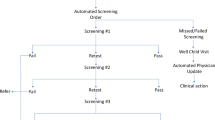Abstract
Screening for critical congenital heart disease (CCHD) in newborns based on a 2009 Swedish study has become the standard of care despite the complexity of the algorithm. A simplified algorithm which might increase the false-positive rate was proposed in 2020 but not formally endorsed by the American Academy of Pediatrics. We sought to determine how the current protocol and the proposed changes are perceived by clinicians. We performed an anonymous survey of professionals involved in the care of newborns regarding their perception of the current and proposed CCHD screening algorithms. 335 responses were evaluated. Less than 2% of respondents were dissatisfied with the existing screening algorithm or felt it was difficult to perform. 47% endorsed and 12% opposed the adoption of the proposed modifications with those most familiar with the proposed changes more likely to endorse them. Although many providers would accept a higher false-positive rate in CCHD screening, those who would have to transfer a baby from the birth site for assessment after a failed CCHD screening were less tolerant of an increased false-positive rate. Although the existing CCHD screening mechanisms appear to be very well received, the proposed changes to the CCHD algorithm were viewed positively by many respondents. Changes in this algorithm would likely be better tolerated in those setting where the consequences of a failed CCHD screening are more easily addressed.
Similar content being viewed by others
References
Wren C, Reinhardt Z, Khawaja K (2008) Twenty-year trends in diagnosis of life-threatening neonatal cardiovascular malformations. Arch Dis Child Fetal Neonatal Ed 93(1):F33–F35
Mellander M, Sunnegardh J (2006) Failure to diagnose critical heart malformations in newborns before discharge–an increasing problem? Acta Paediatr 95(4):407–413
Hoffman JI, Kaplan S (2002) The incidence of congenital heart disease. J Am Coll Cardiol 39(12):1890–1900
de-Wahl Granelli A, Wennergren M, Sandberg K, Mellander M, Bejlum C, Inganas L et al (2009) Impact of pulse oximetry screening on the detection of duct dependent congenital heart disease: a Swedish prospective screening study in 39,821 newborns. BMJ 338:a3037
Martin GR, Beekman RH 3rd, Mikula EB, Fasules J, Garg LF, Kemper AR et al (2013) Implementing recommended screening for critical congenital heart disease. Pediatrics 132(1):e185–e192
Kemper AR, Mahle WT, Martin GR, Cooley WC, Kumar P, Morrow WR et al (2011) Strategies for implementing screening for critical congenital heart disease. Pediatrics 128(5):e1259–e1267
Abouk R, Grosse SD, Ailes EC, Oster ME (2017) Association of US state implementation of newborn screening policies for critical congenital heart disease with early infant cardiac deaths. JAMA 318(21):2111–2118
Martin GR, Ewer AK, Gaviglio A, Hom LA, Saarinen A, Sontag M et al (2020) Updated strategies for pulse oximetry screening for critical congenital heart disease. Pediatrics. https://doi.org/10.1542/peds.2019-1650
Garg LF, Van Naarden BK, Knapp MM, Anderson TM, Koppel RI, Hirsch D et al (2013) Results from the New Jersey statewide critical congenital heart defects screening program. Pediatrics 132(2):e314–e323
Schwartz BN, Hom LA, Von Kohorn I, Becker J, Cuzzi SS, Clarke SEG et al (2021) Newborn pulse oximetry screening at a community hospital: an 8-year experience. Pediatrics. https://doi.org/10.1542/peds.2020-049847
Ewer AK, Middleton LJ, Furmston AT, Bhoyar A, Daniels JP, Thangaratinam S et al (2011) Pulse oximetry screening for congenital heart defects in newborn infants (PulseOx): a test accuracy study. Lancet 378(9793):785–794
Zhao QM, Ma XJ, Ge XL, Liu F, Yan WL, Wu L et al (2014) Pulse oximetry with clinical assessment to screen for congenital heart disease in neonates in China: a prospective study. Lancet 384:747
Wisconsin Interactive Statistics on Health (WISH) (2020) Birth counts module. Accessed from https://www.dhs.wisconsin.gov/wish/birth/form.htm.
Lhost JJ, Goetz EM, Belling JD, van Roojen WM, Spicer G, Hokanson JS (2014) Pulse oximetry screening for critical congenital heart disease in planned out-of-hospital births. J Pediatr 165:485
Miller KK, Vig KS, Goetz EM, Spicer G, Yang AJ, Hokanson JS (2016) Pulse oximetry screening for critical congenital heart disease in planned out of hospital births and the incidence of critical congenital heart disease in the plain community. J Perinatol 36(12):1088–1091
Williams KB, Horst M, Hollinger EA, Freedman J, Demczko MM, Chowdhury D (2021) Newborn pulse oximetry for infants born out-of-hospital. Pediatrics. https://doi.org/10.1542/peds.2020-048785
Beissel DJGEM, Hokanson JS (2011) Pulse oximetry screening for congenital heart disease in Wisconsin. Congenit Heart Dis 6(5):521–522
McClain MR, Hokanson JS, Grazel R, Van Naarden BK, Garg LF, Morris MR et al (2017) Critical congenital heart disease newborn screening implementation: lessons learned. Matern Child Health J 21(6):1240–1249
Acknowledgements
We would like to thank the members of the Wisconsin Guild of Midwives, Wisconsin Association for Perinatal Care, Wisconsin Chapter of the AAP, Association of Women’s Health, Obstetric and Neonatal Nurses, AAP section on Cardiology and Cardiac Surgery and the online Pediheart community for participating in this project.
Author information
Authors and Affiliations
Contributions
All authors contributed to the study conception and design. JCW and JSH wrote and distributed the survey. XZ supervised JCW in data analysis. JCW wrote the first draft of this manuscript with subsequent contributions by XZ and JSH.
Corresponding author
Ethics declarations
Conflict of interest
No funds, grants, or other support were sought or received. The authors received no compensation to produce this manuscript. The authors have no relevant financial or non-financial interests to disclose.
Additional information
Publisher's Note
Springer Nature remains neutral with regard to jurisdictional claims in published maps and institutional affiliations.
There are no prior publications with any overlapping information, although the results of this project were presented in poster form at the 2021 Midwest Pediatric Cardiology Society Annual Meeting and the 2021 AAP Section on Cardiology and Cardiac Surgery meeting.
Supplementary Information
Below is the link to the electronic supplementary material.
Rights and permissions
About this article
Cite this article
Walters, J.C., Zhang, X. & Hokanson, J.S. Providers’ Attitudes to Proposed Changes in the Critical Congenital Heart Disease Screening Algorithm. Pediatr Cardiol 43, 1354–1358 (2022). https://doi.org/10.1007/s00246-022-02858-4
Received:
Accepted:
Published:
Issue Date:
DOI: https://doi.org/10.1007/s00246-022-02858-4




